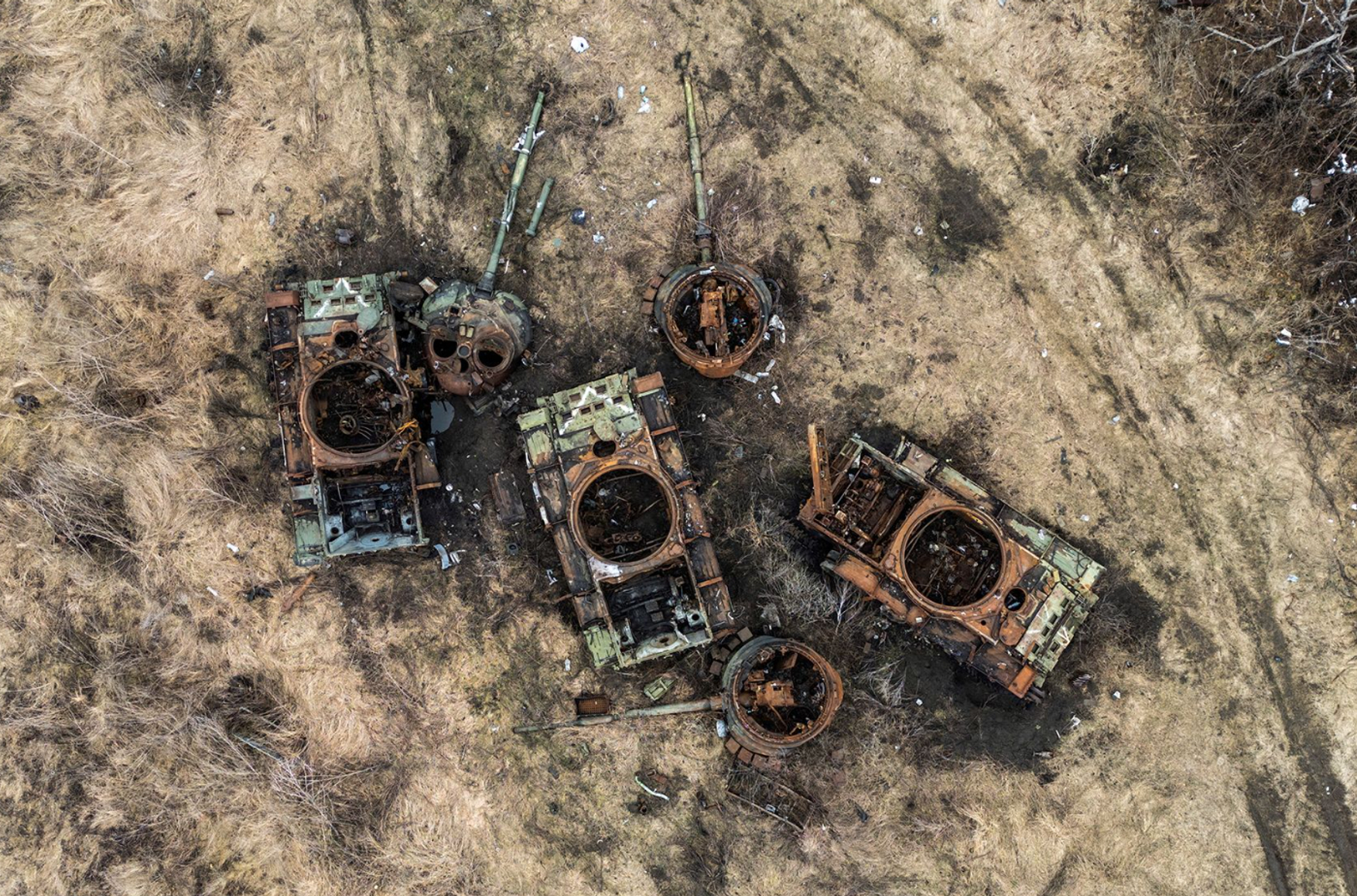

Russia’s full-scale invasion of Ukraine has led to the bloodiest conflict in Europe since World War II. It has also resulted in the largest depletion of military equipment in 80 years. Vast stockpiles of primarily Soviet-era weaponry, originally designed at the height of the Cold War for use in a global confrontation with the Western world, have been exhausted at an unprecedented rate. According to the latest available estimates, Russia’s armed forces have already lost more than half of their available military hardware. If no unexpected developments occur, the most likely scenario involves a gradual decline in combat intensity by late 2025 or early 2026, driven by a basic shortage of tanks, armored vehicles, and artillery. Alternatively, the nature of the war may shift, with both sides relying more on missile and drone strikes against rear positions, while the front lines remain largely static.
Content
Military equipment losses in the Russia-Ukraine war
How do Russia and Ukraine replace lost equipment?
How the equipment shortage has already changed the war
How will both sides continue fighting?
Military equipment losses in the Russia-Ukraine war
The military tracking project Oryx estimates that Russia has lost over 20,000 units of military hardware since Feb. 24, 2022, while Ukrainian losses stand at around 7,600. Focusing on armored vehicles alone — tanks, infantry fighting vehicles (IFVs), and armored personnel carriers (APCs) — Russia has lost 11,600, while Ukraine has lost 3,800.
Examining only destroyed equipment (excluding damaged, abandoned, or captured vehicles), the Russian Armed Forces have lost 2,600 tanks (against Ukraine’s 700), 1,900 APCs ( Ukraine’s figure is 800), and 4,100 IFVs (to Ukraine’s 900). The total number of destroyed armored vehicles alone exceeds 11,000 units.
Meat-grinder assault
“Meat-grinder assaults” refer to the practice of sending infantry to storm enemy positions without proper preparation or support from artillery, drones, or armored vehicles, often resulting in heavy casualties among the attacking forces.
Shahid-mobile
“Shahid-mobile” is a slang term for a vehicle loaded with explosives, either remotely operated or driven by a suicide bomber.
The term “shahid” (from Arabic شهيد, meaning “martyr”) is often used in Russian-language security and counterterrorism contexts to refer to suicide bombers, particularly those linked to Islamist extremist groups. This term became widely used in Russian media and government discourse during and after the Chechen Wars (1990s-2000s), when Chechen and North Caucasus insurgents carried out suicide attacks against Russian forces and civilians.
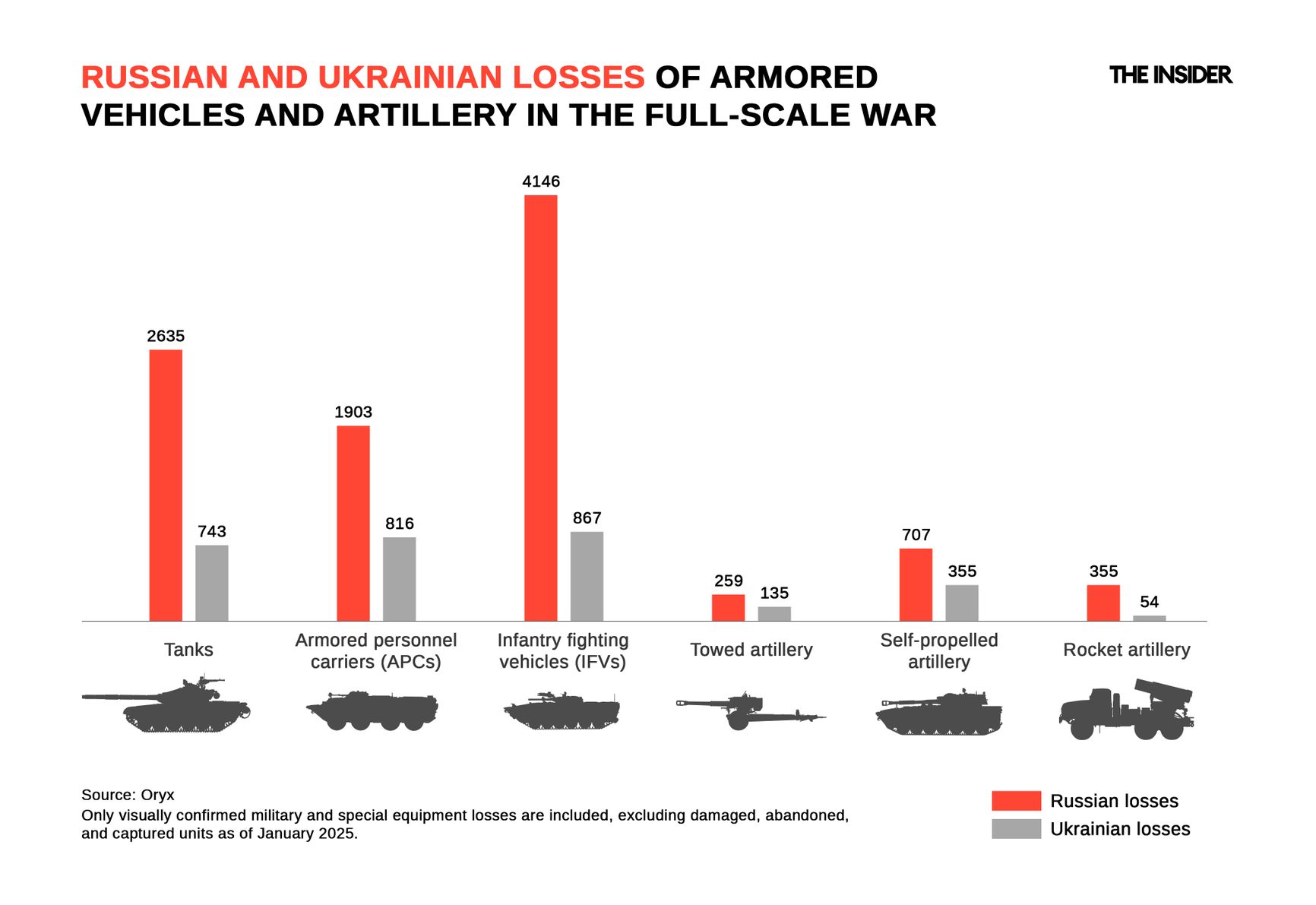
In the artillery category — towed, self-propelled, and multiple-launch rocket systems (MLRS) — Russian losses are also significantly higher, with nearly 2,000 destroyed systems. Notably, both sides most often lose the same types of Soviet-era equipment, manufactured before the 1991 collapse of the USSR. Around 50% of the equipment Russia has lost comes from its Soviet legacy stocks, which are gradually being depleted.
Other open-source databases, including the pro-Ukrainian WarSpotting and the pro-Russian LostArmour, provide comparable figures: around 10,000 armored vehicles lost by Russia and 3,000 by Ukraine. However, these estimates are not entirely reliable, as they may include duplicate records (damaged vehicles repaired and returned to service), fabricated footage, destroyed decoys mistaken for real losses, and unverified losses that do not appear in photo or video evidence. These figures also fail to illustrate the current rate of hardware depletion in offensive operations.
Combat conditions in 2024 differ significantly from those in 2022 or even 2023. For example, during Ukraine’s Kursk offensive (Aug. 6 – Oct. 7, 2024), Ukrainian forces lost an average of 10 tanks, 35 IFVs and APCs, and 50 armored vehicles per month. Meanwhile, in Russia’s ongoing Pokrovsk offensive — launched on Oct. 10, 2023, and still active — Russian losses average 40 tanks, over 80 IFVs and APCs, and fewer than 4 armored vehicles per month.
How do Russia and Ukraine replace lost equipment?
For the Russian military, the primary source of heavy equipment remains Soviet-era stockpiles. New production is nowhere near sufficient to compensate for battlefield losses. T-90M tanks are the only model still produced from scratch, with an estimated 250 units built per year. Military analyst Andriy Tarasenko told The Insider that Russia likely produces no more than 300 new tanks annually — less than half of what is lost in offensives like the one on Avdiivka and Pokrovsk.
Meat-grinder assault
“Meat-grinder assaults” refer to the practice of sending infantry to storm enemy positions without proper preparation or support from artillery, drones, or armored vehicles, often resulting in heavy casualties among the attacking forces.
Shahid-mobile
“Shahid-mobile” is a slang term for a vehicle loaded with explosives, either remotely operated or driven by a suicide bomber.
The term “shahid” (from Arabic شهيد, meaning “martyr”) is often used in Russian-language security and counterterrorism contexts to refer to suicide bombers, particularly those linked to Islamist extremist groups. This term became widely used in Russian media and government discourse during and after the Chechen Wars (1990s-2000s), when Chechen and North Caucasus insurgents carried out suicide attacks against Russian forces and civilians.
Among infantry fighting vehicles, the BMP-3 is the only Russian IFV in mass production, with 463 units built in 2023. The modern BTR-82 APC is produced at a rate of 300–400 per year, and that figure includes the modernization of older models.
In the artillery category, Russia’s key limitation lies in its inability to manufacture gun barrels. As a result, there have been notable instances of Russia abandoning efforts to reactivate certain artillery systems from storage. For rocket artillery, the primary challenge is the production of a sufficient number of rockets to sustain operations.
A group of independent researchers using satellite imagery to analyze Russia’s Soviet-era equipment stockpiles at open storage bases released a comprehensive report at the end of 2024. Their findings indicate that over the course of the full-scale war, across key categories of military equipment (tanks, IFVs, APCs, and artillery systems), only 41% to 52% of pre-war reserves remain in storage.
Meat-grinder assault
“Meat-grinder assaults” refer to the practice of sending infantry to storm enemy positions without proper preparation or support from artillery, drones, or armored vehicles, often resulting in heavy casualties among the attacking forces.
Shahid-mobile
“Shahid-mobile” is a slang term for a vehicle loaded with explosives, either remotely operated or driven by a suicide bomber.
The term “shahid” (from Arabic شهيد, meaning “martyr”) is often used in Russian-language security and counterterrorism contexts to refer to suicide bombers, particularly those linked to Islamist extremist groups. This term became widely used in Russian media and government discourse during and after the Chechen Wars (1990s-2000s), when Chechen and North Caucasus insurgents carried out suicide attacks against Russian forces and civilians.
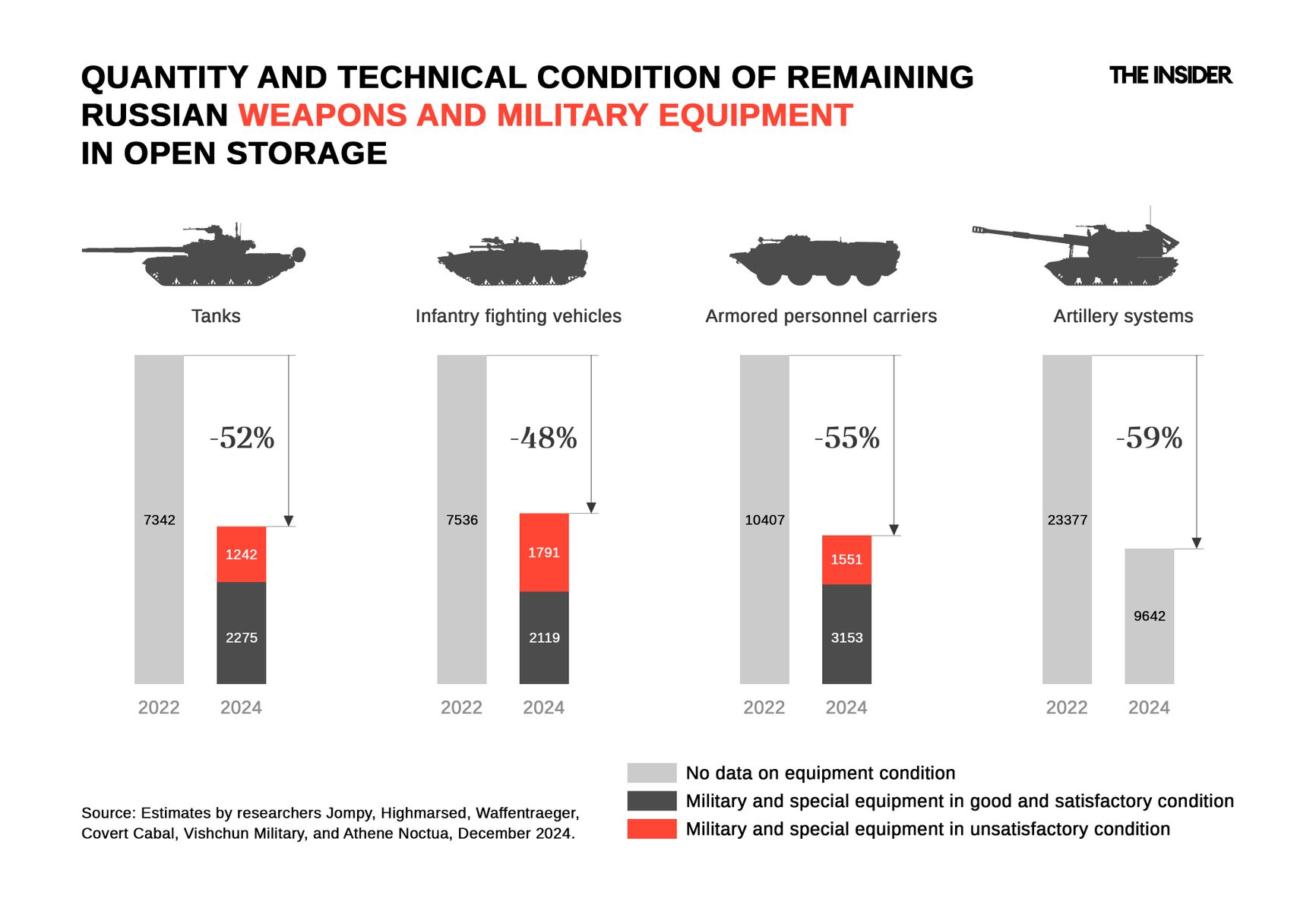
The remaining stockpiles of military equipment in Russia are largely in poor technical condition. In other words, it is highly unlikely that this equipment can be repaired and sent to the front lines. Instead, most of these vehicles will likely serve as parts donors for relatively better-preserved models.
Meat-grinder assault
“Meat-grinder assaults” refer to the practice of sending infantry to storm enemy positions without proper preparation or support from artillery, drones, or armored vehicles, often resulting in heavy casualties among the attacking forces.
Shahid-mobile
“Shahid-mobile” is a slang term for a vehicle loaded with explosives, either remotely operated or driven by a suicide bomber.
The term “shahid” (from Arabic شهيد, meaning “martyr”) is often used in Russian-language security and counterterrorism contexts to refer to suicide bombers, particularly those linked to Islamist extremist groups. This term became widely used in Russian media and government discourse during and after the Chechen Wars (1990s-2000s), when Chechen and North Caucasus insurgents carried out suicide attacks against Russian forces and civilians.
The remaining stockpiles of military equipment in Russia are largely in poor technical condition.
For example, a significant portion of the remaining tank reserves consists of hopelessly outdated models, such as the T-62, while the number of repairable tanks from more modern series is limited to just a few hundred.
Meat-grinder assault
“Meat-grinder assaults” refer to the practice of sending infantry to storm enemy positions without proper preparation or support from artillery, drones, or armored vehicles, often resulting in heavy casualties among the attacking forces.
Shahid-mobile
“Shahid-mobile” is a slang term for a vehicle loaded with explosives, either remotely operated or driven by a suicide bomber.
The term “shahid” (from Arabic شهيد, meaning “martyr”) is often used in Russian-language security and counterterrorism contexts to refer to suicide bombers, particularly those linked to Islamist extremist groups. This term became widely used in Russian media and government discourse during and after the Chechen Wars (1990s-2000s), when Chechen and North Caucasus insurgents carried out suicide attacks against Russian forces and civilians.
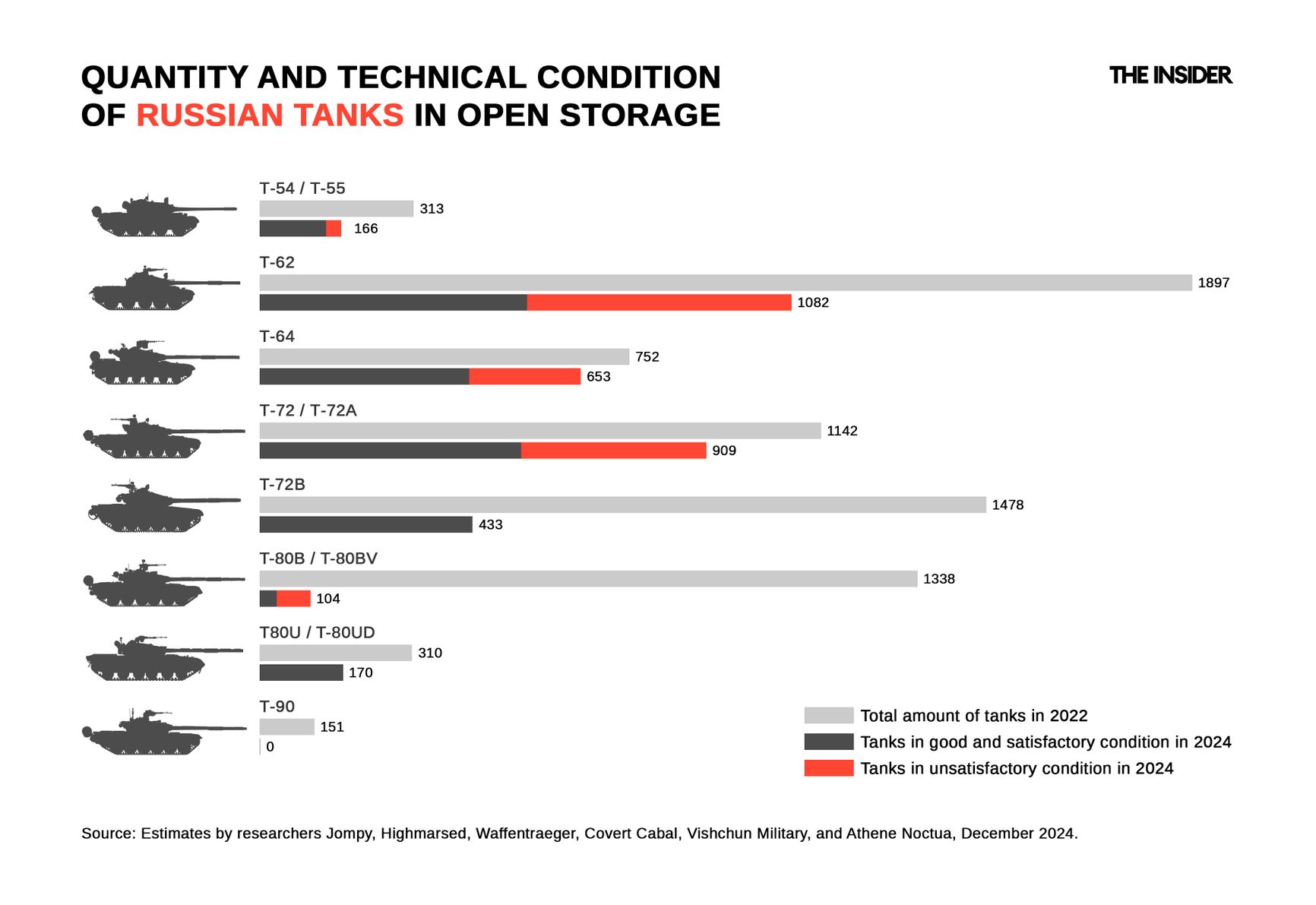
In the infantry fighting vehicle (IFV) and armored personnel carrier (APC) categories, some models, such as the MT-LB, are already completely depleted, while others exist mostly in the form of scrap metal.
Meat-grinder assault
“Meat-grinder assaults” refer to the practice of sending infantry to storm enemy positions without proper preparation or support from artillery, drones, or armored vehicles, often resulting in heavy casualties among the attacking forces.
Shahid-mobile
“Shahid-mobile” is a slang term for a vehicle loaded with explosives, either remotely operated or driven by a suicide bomber.
The term “shahid” (from Arabic شهيد, meaning “martyr”) is often used in Russian-language security and counterterrorism contexts to refer to suicide bombers, particularly those linked to Islamist extremist groups. This term became widely used in Russian media and government discourse during and after the Chechen Wars (1990s-2000s), when Chechen and North Caucasus insurgents carried out suicide attacks against Russian forces and civilians.
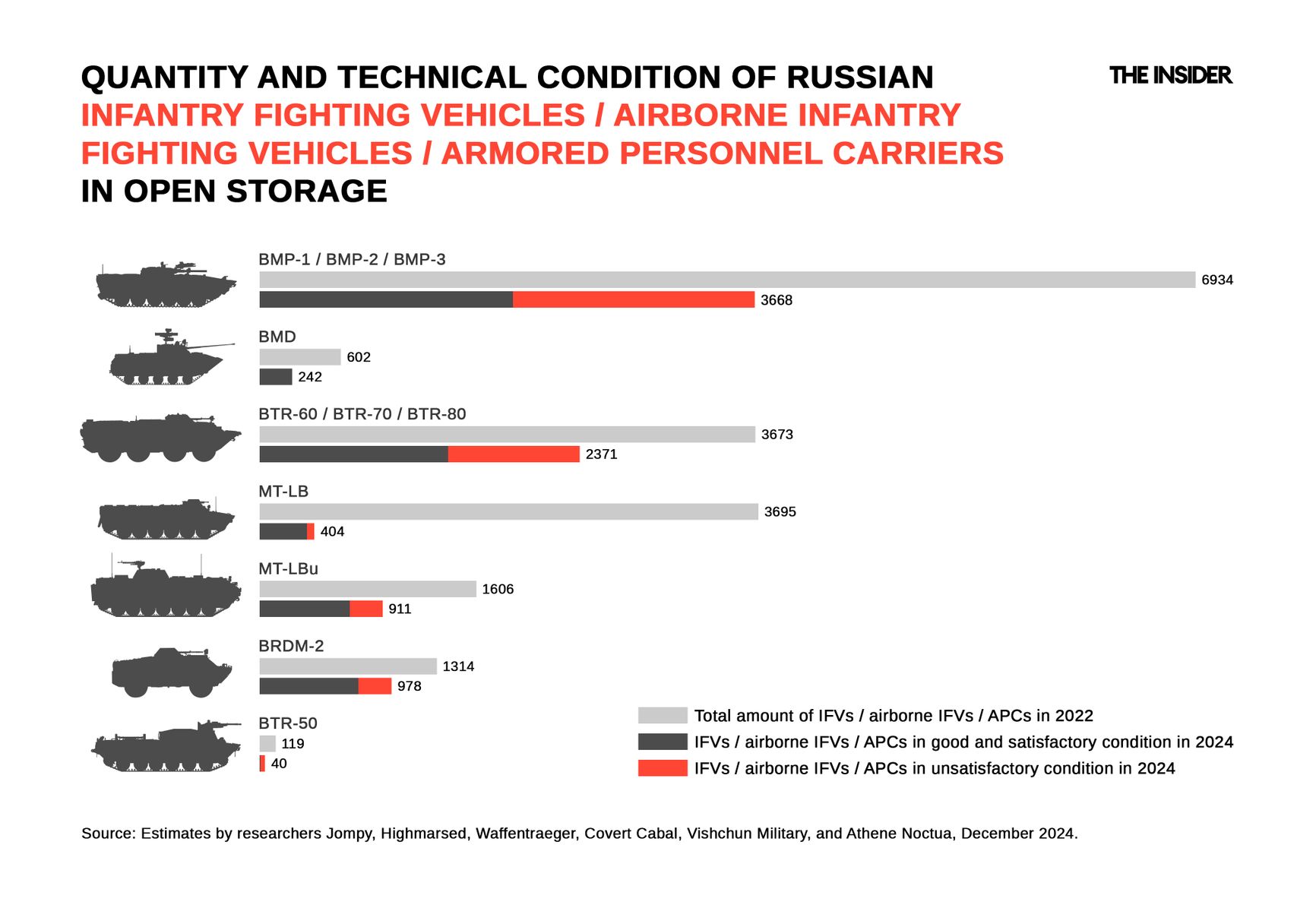
Despite nearly three years of war, artillery stockpiles appear substantial, but as previously noted, the critical issue is the ability to produce barrels and maintain sufficient ammunition supplies.
Meat-grinder assault
“Meat-grinder assaults” refer to the practice of sending infantry to storm enemy positions without proper preparation or support from artillery, drones, or armored vehicles, often resulting in heavy casualties among the attacking forces.
Shahid-mobile
“Shahid-mobile” is a slang term for a vehicle loaded with explosives, either remotely operated or driven by a suicide bomber.
The term “shahid” (from Arabic شهيد, meaning “martyr”) is often used in Russian-language security and counterterrorism contexts to refer to suicide bombers, particularly those linked to Islamist extremist groups. This term became widely used in Russian media and government discourse during and after the Chechen Wars (1990s-2000s), when Chechen and North Caucasus insurgents carried out suicide attacks against Russian forces and civilians.
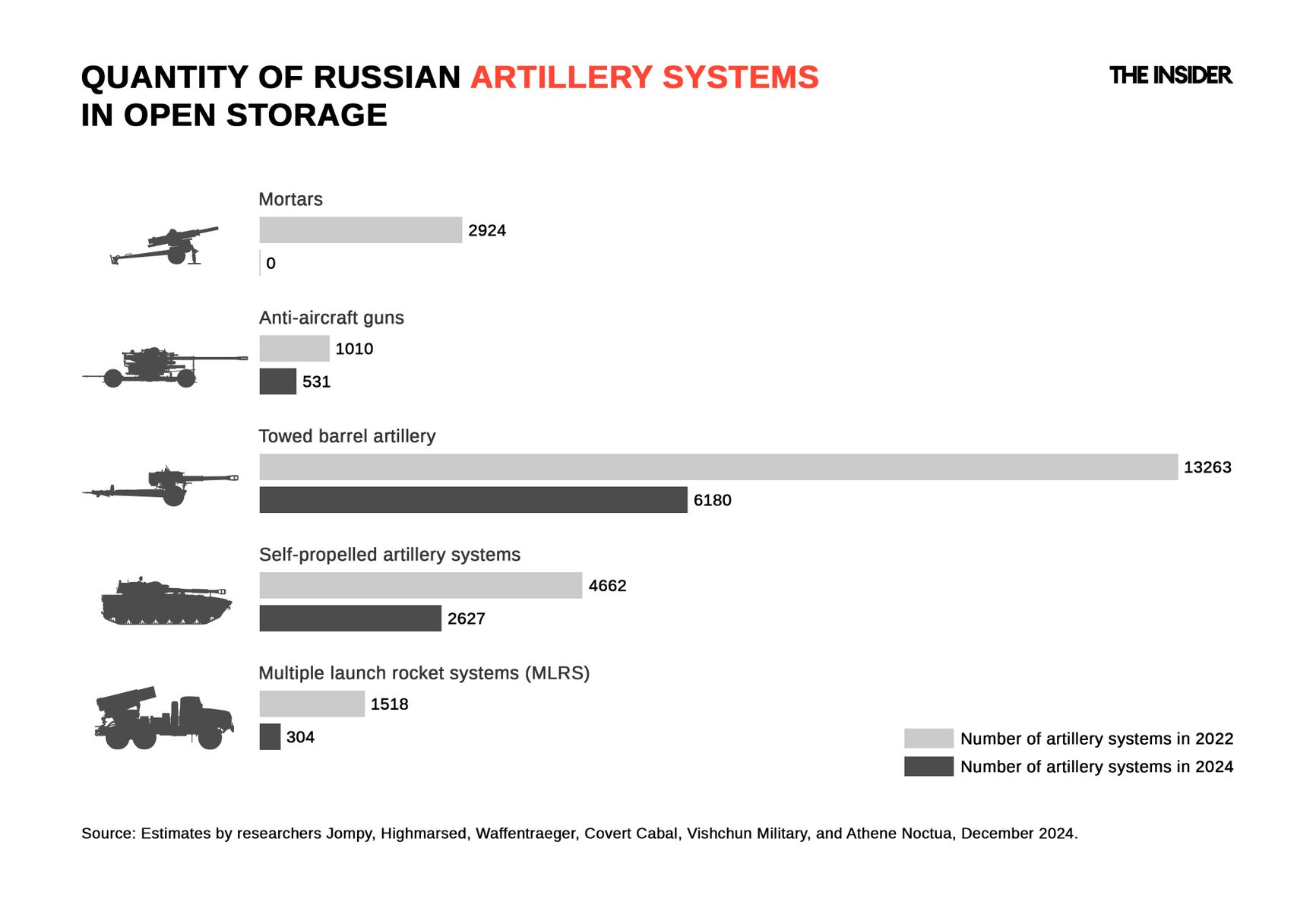
Taking all these factors into account, the available reserves for rapid deployment to the front lines are estimated at around 2,000 tanks, 2,000 IFVs, and 3,000 APCs. For comparison, in 1990, the Soviet Union was estimated to possess 63,900 tanks (excluding those of Warsaw Pact allies), 66,900 artillery units, and 76,500 IFVs and APCs.
According to U.S. intelligence estimates, between 1975 and 1988 the Soviet defense industry manufactured over 40,000 tanks, 36,500 IFVs, and nearly 38,000 APCs. Much of this Cold War-era armored and artillery stockpile — originally built for a potential large-scale conflict with the West — was dismantled in the 1990s and 2000s, or else was sold to countries in Africa and Asia. The remaining reserves have now been largely depleted in the Russia-Ukraine war.
Beyond the quantity and condition of the stockpiled equipment, a key limiting factor is the capacity of Russia’s repair, refurbishment, and modernization facilities.
Russia’s armored repair plants (BTRZ) are known for their low technological standards and poor work culture. For instance, at Plant No. 103 in Atamanovka, Zabaykalsky Krai — one of Russia’s largest armored repair facilities — three workers died in December 2021 after drinking methyl alcohol, mistaking it for ethanol.
Meat-grinder assault
“Meat-grinder assaults” refer to the practice of sending infantry to storm enemy positions without proper preparation or support from artillery, drones, or armored vehicles, often resulting in heavy casualties among the attacking forces.
Shahid-mobile
“Shahid-mobile” is a slang term for a vehicle loaded with explosives, either remotely operated or driven by a suicide bomber.
The term “shahid” (from Arabic شهيد, meaning “martyr”) is often used in Russian-language security and counterterrorism contexts to refer to suicide bombers, particularly those linked to Islamist extremist groups. This term became widely used in Russian media and government discourse during and after the Chechen Wars (1990s-2000s), when Chechen and North Caucasus insurgents carried out suicide attacks against Russian forces and civilians.
Russia’s armored repair plants are known for their low technological standards.
Over the past three years, Russia has almost completely exhausted its stock of readily deployable military equipment. The remaining vehicles are only fit for cannibalization, with two to three decommissioned units needed to restore a single operational machine.
Throughout the war, the Kremlin has effectively been fighting “on credit,” as new equipment deliveries — including those for restored units pulled from storage — have never matched the rate of battlefield losses.
According to military analyst Andriy Tarasenko, Russia’s repairable equipment reserves may be completely depleted within 12–18 months:
“Satellite analysis of storage bases suggests that unless Russia begins mass production of 700-1,000 new armored vehicles per year within the next 1-1.5 years, its stockpiles for repair and modernization will run out.
Given the current pace of production, replacing losses with newly built vehicles is impossible and would require unconventional solutions, such as purchasing old equipment from countries like India or launching an unprecedented 'new industrialization' to restart large-scale armored vehicle manufacturing. This would demand enormous material resources and time.”
Most Western intelligence assessments (1, 2, 3) also indicate that Russia will face a critical shortage of military hardware by late 2025 or early 2026, assuming the intensity of combat remains unchanged.
Of course, Russia's military leadership will not allow its tank and IFV reserves to be depleted entirely. In practice, the declining capacity to replace losses will force Russia to either modify its strategy and tactics or find alternative sources of armored vehicles.
Meat-grinder assault
“Meat-grinder assaults” refer to the practice of sending infantry to storm enemy positions without proper preparation or support from artillery, drones, or armored vehicles, often resulting in heavy casualties among the attacking forces.
Shahid-mobile
“Shahid-mobile” is a slang term for a vehicle loaded with explosives, either remotely operated or driven by a suicide bomber.
The term “shahid” (from Arabic شهيد, meaning “martyr”) is often used in Russian-language security and counterterrorism contexts to refer to suicide bombers, particularly those linked to Islamist extremist groups. This term became widely used in Russian media and government discourse during and after the Chechen Wars (1990s-2000s), when Chechen and North Caucasus insurgents carried out suicide attacks against Russian forces and civilians.
Russia's military leadership will not allow its tank and IFV reserves to be depleted entirely.
Estimating Ukraine’s stockpiles is more difficult. Since the start of the war, Kyiv has gradually replaced its Soviet-era equipment with Soviet-designed vehicles from former Warsaw Pact and other allied nations, including locally modernized versions. Ukraine has also been supplied with Western-produced equipment, ranging from obsolete models to cutting-edge systems.
In the early stages of the war, Russia’s abandoned and captured equipment played a crucial role in replenishing Ukrainian stockpiles. However, as the war progressed, Western military aid and Ukraine’s own production took over as the primary sources of replacement hardware.
How the equipment shortage has already changed the war
Ukrainian forces are largely on the defensive along the front line. Even during offensive operations, such as the Kursk offensive, Ukraine relies on a limited range of equipment, primarily armored fighting vehicles rather than scarce IFVs and tanks.
Meanwhile, in the Russian army, logistical shortages have led to bizarre battlefield improvisations. Rear-area vehicles like the MT-LB have been converted into makeshift combat platforms, replete with various weapon systems and armor configurations. Some of these adaptations resemble suicide vehicles — known colloquially as “Shahid-mobiles” — packed with explosives.
Beyond that, the lack of conventional vehicles has led to highly unconventional assault tactics, including attacks using motorcycles, quad bikes, all-terrain vehicles (ATVs), electric scooters, and even civilian cars. Meanwhile, human wave attacks — the infamous “meat-grinder assaults” — continue in areas where conditions allow.
Meat-grinder assault
“Meat-grinder assaults” refer to the practice of sending infantry to storm enemy positions without proper preparation or support from artillery, drones, or armored vehicles, often resulting in heavy casualties among the attacking forces.
Shahid-mobile
“Shahid-mobile” is a slang term for a vehicle loaded with explosives, either remotely operated or driven by a suicide bomber.
The term “shahid” (from Arabic شهيد, meaning “martyr”) is often used in Russian-language security and counterterrorism contexts to refer to suicide bombers, particularly those linked to Islamist extremist groups. This term became widely used in Russian media and government discourse during and after the Chechen Wars (1990s-2000s), when Chechen and North Caucasus insurgents carried out suicide attacks against Russian forces and civilians.
The shortage of equipment both on the front lines and in rear positions makes large-scale breakthroughs virtually impossible, as evidenced by the highly limited gains made by Russian forces during their general offensive since the fall of 2023.
Even pro-Kremlin experts acknowledge that Russia’s offensive tactics have been reduced to small infantry groups, no larger than a platoon, advancing on foot. In reality, neither the Russian nor the Ukrainian armed forces now maintain fully operational motorized rifle or tank divisions, as armored vehicles and artillery systems are being used in ways that deviate significantly from standard military doctrine — primarily due to shortages.
Meat-grinder assault
“Meat-grinder assaults” refer to the practice of sending infantry to storm enemy positions without proper preparation or support from artillery, drones, or armored vehicles, often resulting in heavy casualties among the attacking forces.
Shahid-mobile
“Shahid-mobile” is a slang term for a vehicle loaded with explosives, either remotely operated or driven by a suicide bomber.
The term “shahid” (from Arabic شهيد, meaning “martyr”) is often used in Russian-language security and counterterrorism contexts to refer to suicide bombers, particularly those linked to Islamist extremist groups. This term became widely used in Russian media and government discourse during and after the Chechen Wars (1990s-2000s), when Chechen and North Caucasus insurgents carried out suicide attacks against Russian forces and civilians.
Neither the Russian nor the Ukrainian armed forces now maintain fully operational motorized rifle or tank divisions.
How will both sides continue fighting?
Offensive operations require a certain degree of mechanization and motorization of infantry units. With severe shortages of wheeled and tracked armored vehicles, the already slow pace of territorial advances will only continue to decline. The same applies to self-propelled and towed artillery, including tanks used for indirect fire. No amount of loitering munitions or FPV drones can replace full-scale artillery support, making any effective offensive actions nearly impossible.
Unless one side or the other can drastically increase domestic military production or gain access to allied stockpiles of military hardware, the war appears headed for an overall decline in combat intensity.
Speaking with The Insider, Pavel Luzin, a visiting researcher at the Fletcher School of Law and Diplomacy and a senior fellow at the Jamestown Foundation, suggested that the Russian Ministry of Defense will be forced to either adopt tactics used by Middle Eastern militant groups like Hamas and Hezbollah, or reorient its military-industrial complex to produce a narrower range of less advanced combat systems. According to Luzin, Russia may combine both approaches.
On the other hand, Gustav Gressel, a defense policy expert at the European Council on Foreign Relations (ECFR), warns against underestimating the Russian military’s ability to adapt:
“Tactical adaptation means substituting one system with another. For example, as Russia increasingly has problems fielding enough workable gun-artillery, they increasingly rely on air-launched glide bombs for fire support. Unfortunately that works just fine for them. We also see Russians substituting APCs for non combat essential transports with quads, ATVs, motorcycles, and so on.
Operative adaptation would mean to end these large scale offensives to preserve vehicles. Russia could calm down the front while continuing to bomb Ukraine with missile and drone attacks. Or conduct smaller, more targeted offensives.”
In an analysis published last May, The Insider examined how North Korea, China, Iran, and Belarus could aid Putin’s war effort. Since then, evidence has emerged that North Korea has supplied Moscow with self-propelled artillery, anti-tank missile systems, and short-range air defense systems — in addition to the munitions Pyongyang began sending after Kim Jong Un’s visit to Russia in September 2023.
Ukraine’s allies also possess significant stockpiles of military equipment, but political constraints limit their supply. Gressel notes that most Soviet-era stockpiles in former Warsaw Pact countries were either sold off or stripped for parts in the 1990s and 2000s. Nations that still maintain Soviet-era equipment in active service are only willing to provide it to Kyiv if they receive replacement Western systems in exchange. Germany has facilitated some of these equipment swap programs, but on a limited scale. Meanwhile, Western equipment stockpiles will require major repair and modernization efforts before they can be supplied to Ukraine. Additionally, even at modest production levels, Russia is currently manufacturing more new tanks and armored vehicles than Ukraine’s Western allies can provide.
Meat-grinder assault
“Meat-grinder assaults” refer to the practice of sending infantry to storm enemy positions without proper preparation or support from artillery, drones, or armored vehicles, often resulting in heavy casualties among the attacking forces.
Shahid-mobile
“Shahid-mobile” is a slang term for a vehicle loaded with explosives, either remotely operated or driven by a suicide bomber.
The term “shahid” (from Arabic شهيد, meaning “martyr”) is often used in Russian-language security and counterterrorism contexts to refer to suicide bombers, particularly those linked to Islamist extremist groups. This term became widely used in Russian media and government discourse during and after the Chechen Wars (1990s-2000s), when Chechen and North Caucasus insurgents carried out suicide attacks against Russian forces and civilians.
Even at modest production levels, Russia is currently manufacturing more new tanks and armored vehicles than Ukraine’s Western allies can provide.
At its current trajectory, Russia’s depletion of available armored vehicles and artillery systems will severely limit its ability to carry out offensive operations. However, the political situation in Ukraine and among its allies remains uncertain. The key question is whether Ukraine’s political leadership and society can hold out long enough for Russia’s offensive capabilities to deteriorate — and whether Europe and the U.S. will provide sufficient support to ensure this.
Having burned through an enormous amount of military resources in a localized war with Ukraine, the Kremlin will face an almost insurmountable challenge if it is seriously preparing for a new Cold War with the West. To maintain combat readiness, Russia would need to replenish not only frontline units, but also storage reserves, and given the depletion of its Soviet-era stocks, it would need to do this with newly manufactured vehicles, which are far more complex and expensive to produce. By even the most conservative estimates, rebuilding the Russian military’s combat potential would require massive investments in its core assets and take decades to complete.
Meat-grinder assault
“Meat-grinder assaults” refer to the practice of sending infantry to storm enemy positions without proper preparation or support from artillery, drones, or armored vehicles, often resulting in heavy casualties among the attacking forces.
Shahid-mobile
“Shahid-mobile” is a slang term for a vehicle loaded with explosives, either remotely operated or driven by a suicide bomber.
The term “shahid” (from Arabic شهيد, meaning “martyr”) is often used in Russian-language security and counterterrorism contexts to refer to suicide bombers, particularly those linked to Islamist extremist groups. This term became widely used in Russian media and government discourse during and after the Chechen Wars (1990s-2000s), when Chechen and North Caucasus insurgents carried out suicide attacks against Russian forces and civilians.